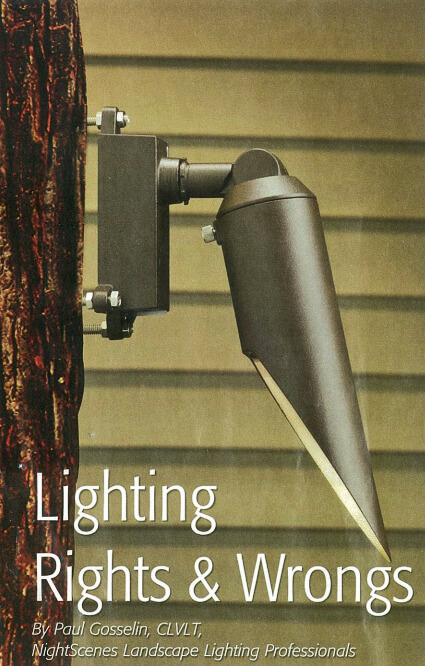
▲ The proper way to mount fixtures to trees is with stainless steel stand-off (hanger) bolts with washers and nuts. Using stainless steel hardware does not harm the tree, and the stand-off bolts allow the tree to grow without growing around the mounting bracket that should be used. This method applies with either upward or downward aimed fixtures.
I hate to say this, but I'm still hearing that my industry, low voltage landscape lighting, has a bad reputation. So, ladies and gentlemen, it is time for me to get back on my soapbox.
There are a couple of big reasons why this is true:
- The first reason is shoddy lighting products that just can't hold up in the natural outdoor environment. You know the products that I'm talking about — the economy merchandise at the big box or discount store, or online sold at a fraction of the cost of a real quality product: cheaply made of inferior materials.
- The other reason is poor installation by people who have no idea what they are doing. This is due to little to no training.
Now imagine a combination of poor products installed poorly. How long could it last? Not long at all! Therein lies the problem — and why all low voltage outdoor lighting gets a bad rap.
(This article shows) examples of what I'm talking about. These are different lighting projects in my area of central Texas. They are all located in a very high income/retirement community; and I'm afraid the clients got ripped off. The worst part of these terrible examples is that I know one of these projects was done by a licensed electrical contractor!
The other day I thought of a way to describe my thoughts, com¬paring those installers who provide cheap outdoor lighting and those of us who do not, and will not, do that kind of work. Think about it this way: There are a lot of "Get It for a Dollar" type of outdoor lighting companies that will sell you some lights at a bargain basement price. Just like the discount store, they will dress you in cheap jeans, a T-shirt and some $10 tennis shoes and call it done. You'll walk out clothed, but may not feel well served or valued. Then there are high quality, custom outdoor lighting companies, like ours and some others. These companies don't just sell lights — they will give you atmosphere and ambience. They will dress you in a custom tailored outfit, made of excellent materials with workmanship that will last a lifetime; and provide the accessories that will make heads turn. They take the time to get to know you and your style to put together the perfect ensemble in a style just for you that will make you feel like a million bucks! There is value in that experience that is impossible to match for a bargain basement price.
There is, of course, a market for both the discount store and the custom tailor with many different department stores in between. The main thing we encourage everyone to remember though, is that very often you get exactly what you pay for. Cheap products installed by someone who doesn't know what they are doing may look pretty good for a short time, but will fail soon; so you are paying for some¬thing temporary, like $10 tennis shoes. Quality products installed by a well-educated professional will last a lifetime, like a fine pair of leather shoes. I've got some shoes in my closet that are 20 years old and still look and feel great.